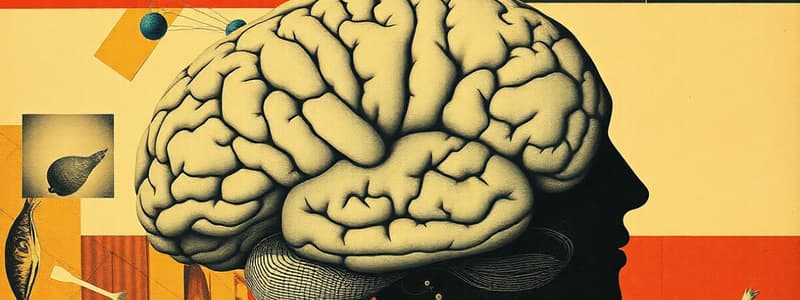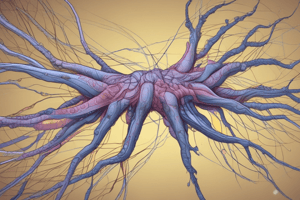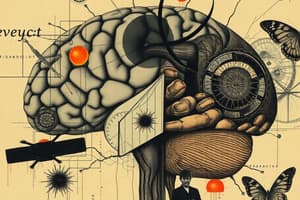Podcast
Questions and Answers
What is the primary function of dendrites in a neuron?
What is the primary function of dendrites in a neuron?
- Produce myelin sheath for axons.
- Transmit electrical signals away from the cell body.
- Provide structural support to the neuron.
- Receive electrical signals from other neurons. (correct)
Which part of the nervous system is responsible for controlling voluntary movements?
Which part of the nervous system is responsible for controlling voluntary movements?
- Peripheral Nervous System
- Central Nervous System
- Autonomic Nervous System
- Somatic Nervous System (correct)
What is the role of the axon in a neuron?
What is the role of the axon in a neuron?
- Transmitting signals away from the cell body. (correct)
- Processing information received from dendrites.
- Producing myelin sheath to insulate the axon.
- Receiving signals from other neurons.
Which of the following is NOT a part of the central nervous system?
Which of the following is NOT a part of the central nervous system?
What is the function of the autonomic nervous system?
What is the function of the autonomic nervous system?
Which type of nerves transmit signals from the brain or spinal cord to muscles and glands?
Which type of nerves transmit signals from the brain or spinal cord to muscles and glands?
Which of the following statements about neurons is TRUE?
Which of the following statements about neurons is TRUE?
What is the approximate length of an axon?
What is the approximate length of an axon?
What is the primary function of the sensorimotor rhythm (SMR)?
What is the primary function of the sensorimotor rhythm (SMR)?
During which stage of sleep do alpha waves dominate the EEG?
During which stage of sleep do alpha waves dominate the EEG?
What is the term for the lack of responses to repeated stimuli in an evoked response experiment?
What is the term for the lack of responses to repeated stimuli in an evoked response experiment?
Which of the following is TRUE about the Electroretinogram (ERG)?
Which of the following is TRUE about the Electroretinogram (ERG)?
What does the Electrooculogram (EOG) primarily measure?
What does the Electrooculogram (EOG) primarily measure?
Which of the following is NOT a true statement about the brain waves associated with deep sleep?
Which of the following is NOT a true statement about the brain waves associated with deep sleep?
The electrical system of the heart is also known as the:
The electrical system of the heart is also known as the:
What does the term 'habituation' refer to in the context of evoked responses?
What does the term 'habituation' refer to in the context of evoked responses?
Which of the following best describes the purpose of an EMG examination?
Which of the following best describes the purpose of an EMG examination?
What is the primary reason for the difficulty in isolating a single muscle fiber during an EMG examination?
What is the primary reason for the difficulty in isolating a single muscle fiber during an EMG examination?
Which of the following is NOT a factor that can affect the velocity of action potentials in motor nerves?
Which of the following is NOT a factor that can affect the velocity of action potentials in motor nerves?
What is the latency period in an EMG?
What is the latency period in an EMG?
What is the primary source of the electrical signals recorded in an EEG?
What is the primary source of the electrical signals recorded in an EEG?
Why is the amplitude of EEG signals relatively low?
Why is the amplitude of EEG signals relatively low?
In an EEG, what is the purpose of comparing electrical activity between the right and left sides of the brain?
In an EEG, what is the purpose of comparing electrical activity between the right and left sides of the brain?
What is the primary reason for the interference from external electrical signals in EEG recordings?
What is the primary reason for the interference from external electrical signals in EEG recordings?
Which part of the heart is responsible for initiating the heartbeat?
Which part of the heart is responsible for initiating the heartbeat?
What is the primary function of the atrioventricular (AV) node in the heart's electrical system?
What is the primary function of the atrioventricular (AV) node in the heart's electrical system?
What is the role of the His-Purkinje system in the heart's electrical conduction?
What is the role of the His-Purkinje system in the heart's electrical conduction?
In what phase of the heartbeat does the heart relax and fill with blood?
In what phase of the heartbeat does the heart relax and fill with blood?
Which of the following statements accurately describes the role of the moderator band in the heart?
Which of the following statements accurately describes the role of the moderator band in the heart?
What is the typical range for a normal resting heart rate?
What is the typical range for a normal resting heart rate?
Which part of the body is responsible for adjusting the heart rate based on the body's needs?
Which part of the body is responsible for adjusting the heart rate based on the body's needs?
What is the primary function of the atria in the heartbeat cycle?
What is the primary function of the atria in the heartbeat cycle?
Which of the following EKG leads measures the potential difference between the right arm and left leg electrodes?
Which of the following EKG leads measures the potential difference between the right arm and left leg electrodes?
Which of the following EKG leads uses the center of resistance between RA and LA as one of its electrodes?
Which of the following EKG leads uses the center of resistance between RA and LA as one of its electrodes?
Which EKG lead measures the potential difference between the left arm and left leg electrodes?
Which EKG lead measures the potential difference between the left arm and left leg electrodes?
Which of the following EKG leads uses the left arm (LA) as one of its electrodes?
Which of the following EKG leads uses the left arm (LA) as one of its electrodes?
Placement of V4 on the chest is different in women, which one is the official recommendation?
Placement of V4 on the chest is different in women, which one is the official recommendation?
Which of the following EKG leads is placed in the 4th intercostal space, left of the sternum?
Which of the following EKG leads is placed in the 4th intercostal space, left of the sternum?
Which of the following conditions is characterized by an irregular pumping pattern of the heart?
Which of the following conditions is characterized by an irregular pumping pattern of the heart?
Which of the following conditions can lead to death of the heart muscle?
Which of the following conditions can lead to death of the heart muscle?
What is the primary function of the SA node?
What is the primary function of the SA node?
During strenuous exercise, what happens to the heart rate and why?
During strenuous exercise, what happens to the heart rate and why?
Which of the following ECG components represents ventricular repolarization?
Which of the following ECG components represents ventricular repolarization?
What does the Q-T interval measure?
What does the Q-T interval measure?
Which of the following statements about the S-T segment is true?
Which of the following statements about the S-T segment is true?
What is the normal duration of the QRS complex in seconds?
What is the normal duration of the QRS complex in seconds?
What is the normal duration of the PR interval in seconds?
What is the normal duration of the PR interval in seconds?
Flashcards
Electricity in medicine
Electricity in medicine
Electricity plays a crucial role in bodily functions and medical applications.
Central nervous system
Central nervous system
Comprises the brain and spinal cord; processes information and coordinates responses.
Autonomic nervous system
Autonomic nervous system
Controls involuntary functions like heart rate and digestion.
Neuron
Neuron
Signup and view all the flashcards
Dendrites
Dendrites
Signup and view all the flashcards
Soma (Cell body)
Soma (Cell body)
Signup and view all the flashcards
Axon
Axon
Signup and view all the flashcards
Efferent nerves
Efferent nerves
Signup and view all the flashcards
Motor Unit
Motor Unit
Signup and view all the flashcards
Action Potential
Action Potential
Signup and view all the flashcards
EMG Examination
EMG Examination
Signup and view all the flashcards
Surface Electrode
Surface Electrode
Signup and view all the flashcards
Concentric Needle Electrode
Concentric Needle Electrode
Signup and view all the flashcards
Latency Period
Latency Period
Signup and view all the flashcards
EEG
EEG
Signup and view all the flashcards
Asymmetrical Activity in EEG
Asymmetrical Activity in EEG
Signup and view all the flashcards
Alpha Waves
Alpha Waves
Signup and view all the flashcards
Paradoxical Sleep
Paradoxical Sleep
Signup and view all the flashcards
Sensorimotor Rhythm (SMR)
Sensorimotor Rhythm (SMR)
Signup and view all the flashcards
Evoked Responses
Evoked Responses
Signup and view all the flashcards
Habituation
Habituation
Signup and view all the flashcards
Electroretinogram (ERG)
Electroretinogram (ERG)
Signup and view all the flashcards
Electrooculogram (EOG)
Electrooculogram (EOG)
Signup and view all the flashcards
Electrocardiogram (ECG)
Electrocardiogram (ECG)
Signup and view all the flashcards
Sinoatrial (SA) Node
Sinoatrial (SA) Node
Signup and view all the flashcards
Atrioventricular (AV) Node
Atrioventricular (AV) Node
Signup and view all the flashcards
His-Purkinje System
His-Purkinje System
Signup and view all the flashcards
Diastole
Diastole
Signup and view all the flashcards
Systole
Systole
Signup and view all the flashcards
Pacemaker of the Heart
Pacemaker of the Heart
Signup and view all the flashcards
Normal Heart Rate
Normal Heart Rate
Signup and view all the flashcards
Ventricular Contraction
Ventricular Contraction
Signup and view all the flashcards
SA node
SA node
Signup and view all the flashcards
Heart rate increase during exercise
Heart rate increase during exercise
Signup and view all the flashcards
ECG P wave
ECG P wave
Signup and view all the flashcards
QRS complex
QRS complex
Signup and view all the flashcards
T wave
T wave
Signup and view all the flashcards
P-R interval
P-R interval
Signup and view all the flashcards
Q-T interval
Q-T interval
Signup and view all the flashcards
Surface electrodes in ECG
Surface electrodes in ECG
Signup and view all the flashcards
Lead II
Lead II
Signup and view all the flashcards
Lead III
Lead III
Signup and view all the flashcards
aVR Configuration
aVR Configuration
Signup and view all the flashcards
aVL Configuration
aVL Configuration
Signup and view all the flashcards
aVF Configuration
aVF Configuration
Signup and view all the flashcards
ECG Purpose
ECG Purpose
Signup and view all the flashcards
Arrhythmia
Arrhythmia
Signup and view all the flashcards
Myocardial Infarction
Myocardial Infarction
Signup and view all the flashcards
Study Notes
Electricity Within the Body
- Physical phenomena involving electricity and magnetism have been observed since ancient times
- Electricity plays an important role in medicine
- Two aspects of electricity and magnetism in medicine:
- Electrical and magnetic effects generated inside the body
- Applications of electricity and magnetism to the surface of the body
- Electricity generated inside the body controls and operates nerves, muscles, and organs
- The nervous system is crucial for all body functions
- The brain receives internal and external signals and makes a proper response
- The nervous system is divided into two parts:
- Central nervous system (consists of the brain, spinal cord, and peripheral nerves)
- Afferent nerves transmit sensory information to the brain or spinal cord
- Efferent nerves transmit information from the brain or spinal cord to muscles and glands
- Autonomic nervous system (controls internal organs such as the heart, intestines, and glands)
- Control of the autonomic nervous system is involuntary
- Central nervous system (consists of the brain, spinal cord, and peripheral nerves)
The Neuron
- The basic structural unit of the nervous system
- Specialized for reception, interpretation, and transmission of electrical signals or messages
- Consists of:
- Dendrites: Short, branched, unmyelinated parts that receive electrical signals from other neurons
- Soma (cell body): Contains the nucleus and associated intracellular structures; receives signals from dendrites
- Axon (nerve fiber): Carries electrical messages away from the cell body (approximately 1 meter long)
- Axon terminals: Transmit messages to muscles, glands, or other neurons
- Synapses: Basic units of communication in the brain; chemical neurotransmitters are released, binding to receptors on the second cell, initiating electrical and biochemical signals
Electrical Potentials of Nerves
- A human body is made of multiple cells composed of different chemical substances (e.g., sodium, potassium, calcium, chloride)
- Cell membranes separate cells from their environment (intracellular and extracellular)
- Intracellular environment is rich in potassium ions, while the extracellular environment has many sodium and chloride ions
- This creates a potential difference (biopotential) between the two environments
- Biopotential can be measured using electrodes, amplified, and monitored to study organ function (e.g., heart, brain, eye, muscles)
- Two types of biopotential:
- Resting potential: The inside of the cell is typically 60-90 mV more negative than the outside
- Action potential: A large momentary change in the resting potential that propagates along the axon, the main method of signal transmission
Electrical Signals from Muscles (EMG)
- Electromyogram (EMG) is the recording of muscle potentials during movement
- A muscle consists of many motor units
- Each motor unit comprises a single branching neuron from the spinal cord and 25-2000 connected muscle fibers (cells)
- Muscle action is initiated by action potentials
- Single muscle cells are usually not monitored in EMG examinations due to difficulties in isolating a single fiber
- EMG electrodes measure the electrical activity of multiple fibers
- Surface electrodes on the skin measure the activity of many motor units
- Concentric needle electrodes inserted under the skin measure single motor unit activity
Electrical Signals from the Brain (EEG)
- Electroencephalogram (EEG) measures very weak complex electrical signals from brain cortex neurons
- Electrodes on the scalp measure the brain's electrical activity
- Reference electrodes are typically attached to the ear
- EEG signals are low amplitude (approximately 50µV)
- External electrical signals often cause interference in EEG signal processing
- EEG is used to diagnose diseases
- Asymmetrical activity is often an indicator of brain disease
- Recording of neural signals from the brain is called electroencephalogram (EEG)
Action of EMG
- Action potential appears in EMG after a latency period between stimulation and response
- EMGs of symmetrical muscles are compared to detect nerve damage, which can affect action potential and latency periods
- Velocity of action potential in motor nerves can decrease due to nerve damage
Electrical Signals from the Eye (ERG and EOG)
- Electroretinogram (ERG) measures potential changes in the retina when exposed to light
- One electrode is in a contact lens over the cornea, and the other is on the ear or forehead
- ERGs can be used to detect retinal inflammation
- Electrooculogram (EOG) measures potential changes due to eye movement
- Two electrodes are placed near the eye
- EOG provides information about eye orientation, angular velocity, and angular acceleration
Electrical Signals from the Heart (ECG)
- Electrocardiogram (ECG) is a graphical representation of the heart's electrical activity
- The electrical system controls all heart events
- The Sinoatrial (SA) node is the heart's pacemaker.
- Atrioventricular (AV) node is located on the interatrial septum.
- The His-Purkinje system is located along the walls of the ventricles
- Cardiac cycle has two phases:
- Systole: Ventricular contraction and pumping of blood
- Diastole: Relaxation of the atria and ventricles, and filling with blood
Additional Notes
- ECG can diagnose cardiac problems such as arrhythmias, heart attacks, and fibrillation.
- Normal heart rate ranges between 60-100 beats/minute.
- Heart rate can increase or decrease depending on the body's needs for oxygen and other function.
Studying That Suits You
Use AI to generate personalized quizzes and flashcards to suit your learning preferences.




